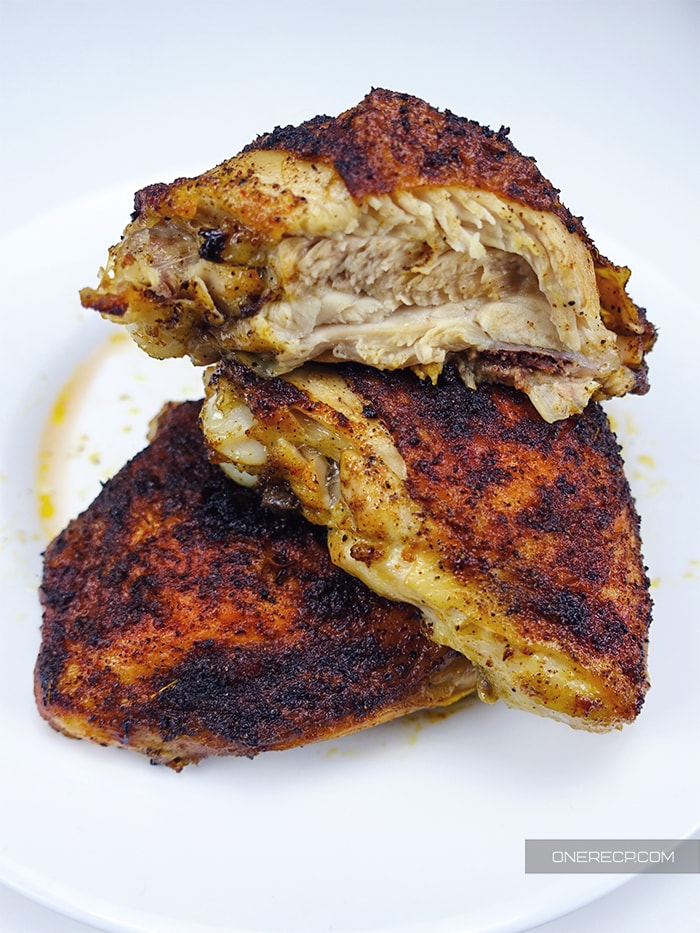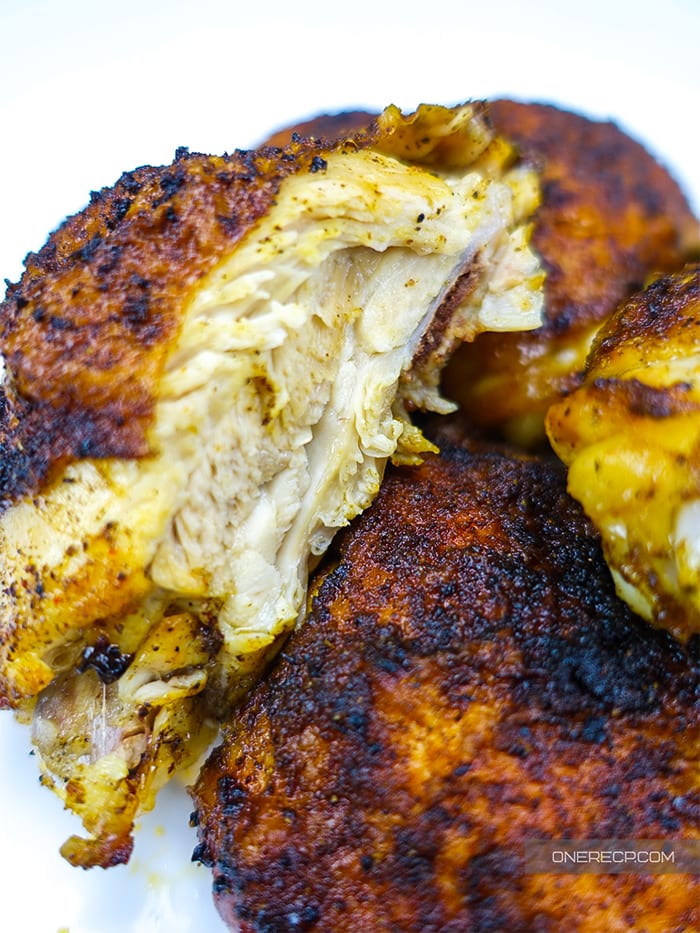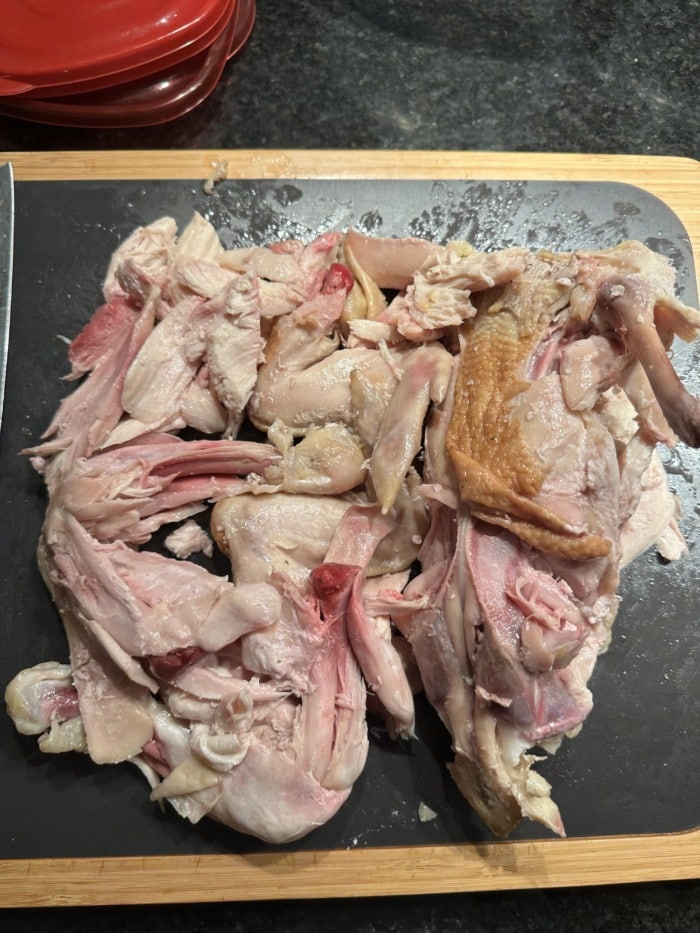You can easily sour the mood on the dinner table by serving your guests a piece of rubbery chicken.
Fortunately there are a few ways to know if chicken thighs are fully cooked through.
The most reliable one is to measure their internal temperature with an instant read thermometer.
You can also rely on your senses and inspect the texture of the meat to see if it’s done.
Contrary to popular belief pink chicken meat is not always a bad sign.
In this article I’ll explain how to tell when chicken thighs are done cooking so you won’t have to worry about serving them undercooked ever again.

How to know if chicken thighs are cooked enough to be eaten?
When chicken thighs are cooked properly, they have a nice juicy texture that’s bursting with flavor.
However, if you try to tell if they’re done by simply observing them you might easily undercook or overcook them.
This is because, unlike white meat like chicken breast, the dark meat in the thighs can often have a pink texture even after it’s been fully cooked through.
Therefore, the best way to know if chicken legs are safe to eat is to measure their internal temperature.
USDA claims that chicken thighs are safe to eat when they reach an internal temperature of 165°F / 73.9°C. To measure their internal temperature, you need to insert an instant read thermometer at the thickest part of the meat. You should keep the probe in for at least 30 seconds to get an accurate reading.
It’s also a good idea to calibrate your thermometer before you attempt to measure the temperature.
To do this, simply place your thermometer in a large glass with ice water.
Then position the thermometer so that it doesn’t touch the bottom or sides of the glass and wait for 30 seconds.
If your thermometer is calibrated properly, it should read 32°F or 0°C.
In case the readings are off, you should add or subtract the difference from the final reading.
Another thing you should keep in mind when measuring the internal temperature of chicken thighs is to not touch the bone.
Since the bone is exposed to heat outside the meat, it usually has a higher temperature and will give you an inaccurate reading.
Having said that, the USDA’s recommendations serve only as a guideline that tells us when chicken thighs are safe to eat.
In fact, cooking chicken thighs to 165°F usually results in a gummy unappetizing texture.
Since they’re rich in dark meat chicken thighs fair better when they’re cooked to an internal temperature of 180°F or 82.2°C.
At this temperature, the fats and connective tissues dissolve completely and make the meat more juicy and tender.

You can also check if your chicken thighs are done without a thermometer. To do this, simply pierce and twist the meat with a fork.
When the thighs reach a high enough temperature, the meat shrinks away from the bone and it’s easier to pull off.
The same method applies can be used for other poultry meat such as turkey when checking if it is done without a thermometer.
Are pink chicken thighs safe to eat?
One of the most popular techniques home cooks use to tell if their chicken thighs are safe to eat is by checking their color.
It goes like this:
If the meat is milky white and opaque then the thighs are done. If it’s pink, then they need a few more minutes in the oven.
In practice however, this is one of the most unreliable ways of gauging the doneness of chicken thighs or any type of poultry meat for that matter.
Color is a bad indicator of how cooked chicken thighs are because the meat is acidic
If you take away anything from this article let it be this:
With chicken doneness, temperature matters more than color.
In fact, the inside of cooked chicken thighs can be pink even after they’ve reached a safe internal temperature of 165°F.
What’s even more interesting is that you can also undercook your thighs or poultry meat if you simply check their color. This includes even boiling chicken.
The reason why this technique is a double edged sword is a protein called myoglobin.
Myoglobin is present in the muscle tissue of turkey, chicken and even pork and makes a pink fluid when it’s mixed with water.
When myoglobin gets heated it undergoes a process called denaturing which changes its structure.
This structural change alters the way myoglobin absorbs light and essentially turns the meat and juices white.
However, the denaturation of myoglobin doesn’t occur at a set temperature, or simply put, chicken meat does not go from pink to white at a set internal temperature.
This is because the acidity of the meat impacts the amount of heat that’s needed for denaturation to occur and turn the meat white.
If the meat has a high pH and is low in acid, it needs to be heated to a higher temperature to denature myoglobin.
In some cases, you may need to cook chicken breast to 180°F before the juices run clear.
And since dark meat has more myoglobin you may need to cook it for even longer to turn “the right” color.
On the flipside, if the thighs are highly acidic you may see clear white juices at temperatures as low as 150°F / 65.6°C.
Chicken is a slightly acidic meat in general.
What could make chicken thighs more acidic than they already are is marinade.
Marinated chicken thighs can often be pink and completely safe to eat as long as they’ve been cooked to an internal temperature of 165°F or more.

by SoftMushySto*l
When the meat is pink near the bone
You may also notice that sometimes chicken meat is only pink near the bone.
This usually happens because the bone structure of broiler chickens is too porous and releases marrow pigments during cooking.
Even though it’s unappealing, this doesn’t necessarily mean that your chicken legs are undercooked.
Related recipe: Quick Pan-Fried Chicken Drumsticks for the Lazy

by lessthandan623
The meat becoming pink from oven gasses
Lastly, your chicken thighs might become pink if they’re exposed to gasses produced by your cooker.
Gas ovens and grills often produce nitric oxide and carbon monoxide as a byproduct of combustion.
These gasses can penetrate the thin skin of younger chickens and make their meat pink despite its internal temperature.
How to tell if the thighs are done when cooking a whole chicken?
When you’re roasting a whole chicken, you need to make sure every part is done at the same time.
However, pulling this off can oftentimes be hard since the breast cooks faster than the dark meat.
Fortunately, you can easily prevent this by making three vertical cuts across each chicken thigh.
This will allow the heat to penetrate the dark meat faster and cook your chicken more evenly.
Having said that, a whole chicken is usually done when the chicken breast reaches an internal temperature of 165°F while the dark meat registers 180°F.
Since your chicken will continue to raise its temperature after it’s out of the oven, it’s best to take it out once the breast hits 160°F.
My short recap
Cooking chicken thighs is fairly simple once you know how to tell when they’re done.
And the best way to do this is to measure their internal temperature with a digital thermometer.
If their internal temperature is 165°F or higher then they’ll be ready for serving regardless of their color.
By the way, here’s one great recipe idea using chicken thighs: Homemade Chicken Soup With Spaghetti Noodles